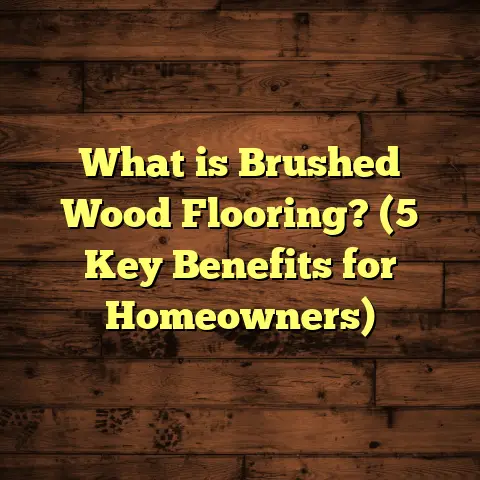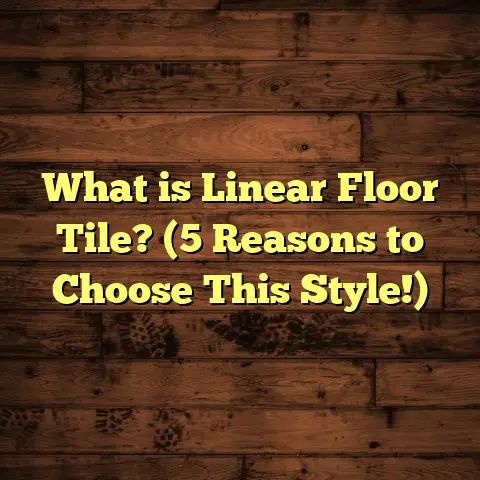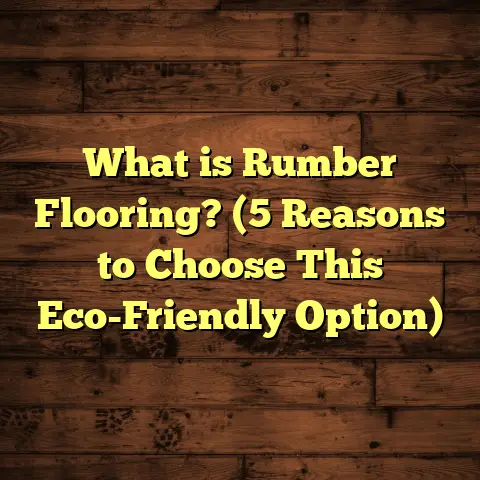What is Hard Surface Flooring? (5 Benefits for Your Home)
Have you ever stopped to think about the floor beneath your feet? I mean, we walk on it every day, but rarely does it get the credit it deserves. It’s ironic how this silent foundation shapes our home’s comfort, style, and even health—yet it’s often an afterthought. I’ve been a flooring contractor for years, and my journey with hard surface flooring has been full of eye-opening moments and lessons that go beyond just picking a pretty surface.
What Is Hard Surface Flooring?
Let’s break it down: hard surface flooring refers to any floor covering made from solid, durable materials such as wood, tile, stone, laminate, or vinyl that mimics these textures. Unlike carpet, which offers softness and insulation, hard surface floors are firm underfoot and built to endure daily wear and tear.
When I first started working in flooring, my understanding was pretty basic—hardwood floors were “hard,” carpet was “soft,” and that was about it. But over time, I learned that hard surface flooring is a broad category with many options, each suited for different rooms, lifestyles, and budgets.
Some popular types include:
- Solid Hardwood: Natural wood planks that offer warmth and timeless beauty.
- Engineered Hardwood: A layered wood product designed for stability in moisture-prone areas.
- Laminate: A budget-friendly option that replicates wood or stone with a photographic layer.
- Luxury Vinyl Plank (LVP): Waterproof vinyl boards that mimic hardwood or tile with impressive realism.
- Ceramic and Porcelain Tile: Durable, water-resistant tiles perfect for kitchens and bathrooms.
- Natural Stone: Marble, granite, slate, and more, for a high-end natural look.
According to the U.S. Census Bureau’s 2022 housing reports, over 60% of newly constructed homes installed some form of hard surface flooring in at least one primary living area. That number reflects not only popularity but also trust in these materials’ performance.
Why I Keep Recommending Hard Surface Flooring
Throughout my career, I’ve installed flooring in hundreds of homes—from cozy cottages to sprawling modern houses—and each time I’m reminded why hard surface flooring keeps winning over homeowners. It’s not just about aesthetics; it’s about practicality and long-term satisfaction.
One memorable project was with a young family who had active kids and two dogs. Their old carpet was stained and worn out fast. They wanted something that looked good but could take a beating. After showing them samples of luxury vinyl plank that was waterproof and scratch resistant, they decided to give it a shot. Six months later, they called me to say how happy they were because it still looked brand new despite all the chaos of daily life.
That kind of feedback is what makes me passionate about sharing the benefits of hard surface flooring. Let’s explore five key reasons why it might be the perfect choice for your home.
1. Durability That Withstands Everyday Life
If there’s one thing I’ve learned in this business, it’s that durability matters more than most people realize—until their floor starts showing damage.
Hard surface flooring generally offers excellent resistance to scratches, dents, stains, and moisture—depending on the material chosen. Solid hardwood can last over 50 years with proper care. Tiles can easily outlive the home itself with minimal wear. Even laminate and luxury vinyl have advanced wear layers making them surprisingly tough.
A Closer Look at Durability by Material
- Solid Hardwood: Made from a single piece of wood, hardwood is strong but can dent or scratch if heavy objects fall on it. It can be refinished multiple times to restore its look.
- Engineered Hardwood: More stable in humid areas due to its layered construction but slightly less durable against deep scratches.
- Laminate: The top layer is a tough resin-infused coating resistant to scratches; however, water damage can cause swelling if not sealed properly.
- Luxury Vinyl Plank: Waterproof and scratch-resistant; ideal for kitchens and basements.
- Ceramic/Porcelain Tile: Highly resistant to wear but can crack if heavy objects impact strongly.
- Natural Stone: Extremely durable but may require sealing to prevent staining.
Real Numbers
Data from the National Wood Flooring Association indicates that hardwood floors in homes sustain an average of 10-15 years of daily wear before refinishing is needed. Tile floors can last well beyond 50 years with minimal maintenance.
One client had porcelain tile installed in their entryway—a high-traffic area—and after ten years reported zero cracks or chips despite heavy foot traffic and occasional dropped tools.
Personal Experience
I once worked on a ranch-style home with 3 large dogs. The owners were worried about claw marks ruining their floors. After consulting with me, they chose luxury vinyl plank with a thick wear layer. Two years later, those floors still looked immaculate despite all the running and scratching.
2. Easy Maintenance Means Less Stress
I get it—cleaning floors isn’t anyone’s favorite chore. But here’s the good news: hard surface floors make upkeep easier compared to carpets or rugs.
A big part of the appeal for my clients is how simple daily cleaning becomes. Most days require just a quick sweep or vacuum followed by a damp mop using a mild cleaner. No need for special shampoos or steam cleaning machines.
Comparing Cleaning Costs
According to the Carpet and Rug Institute, professional carpet cleaning averages between $100-$300 per session every 12-18 months depending on area size and carpet condition. Over a decade, that can add up to thousands of dollars.
Hard surface floors require:
- Sweeping/vacuuming: Minimal cost.
- Mopping: Mild detergents costing pennies per use.
- Occasional refinishing (for hardwood): Every 10-15 years, costing $1.50-$3 per square foot.
My Clients’ Feedback
One homeowner told me she used to dread shampooing carpets because it took hours and left damp smells behind. After switching to engineered hardwood, she said cleaning took minutes and her house felt fresher all the time.
Another family with young kids appreciated how easy it was to wipe up spills without worrying about stains setting into fibers.
3. Health Benefits You Might Not Expect
This benefit surprised me when I first encountered it during a project with allergy sufferers.
Carpets trap allergens like dust mites, pet dander, pollen, and mold spores deep in their fibers. Hard surface floors are less hospitable to these irritants since they don’t absorb them the same way.
Studies Backing This Up
Research published in the Journal of Allergy and Clinical Immunology found that homes with hard surface floors had significantly lower indoor allergen levels than those with wall-to-wall carpeting.
Another study by the American Academy of Allergy Asthma & Immunology showed children living in homes with hard surface flooring experienced fewer asthma attacks compared to those in homes with carpeted floors.
My Own Observations
I had a client whose son had severe dust allergies leading to frequent asthma flare-ups. After we replaced their carpets with luxury vinyl planks throughout their home, they saw noticeable improvements in his respiratory health within weeks.
4. Style Options That Suit Every Taste
Hard surface flooring doesn’t just perform well—it looks amazing too. The variety available today is mind-blowing.
People often tell me they didn’t realize how many choices existed until we started looking at samples together. Whether you want warm wood tones, sleek modern tiles, or rustic stone textures—you’ll find something that fits your style perfectly.
Popular Looks Right Now
- Wide Plank Hardwood: For that modern farmhouse or rustic vibe.
- Matte Finish Engineered Wood: Soft sheen without glare for contemporary spaces.
- Luxury Vinyl Mimicking Exotic Woods: Affordable yet striking visuals.
- Large Format Tiles: Clean lines for minimalist designs.
- Patterned Tiles: Vintage charm or bold statements in kitchens/bathrooms.
- Natural Stone: Timeless elegance with unique veining patterns.
Trends & Data
Houzz’s 2023 homeowner survey found over 70% sought flooring combining aesthetic appeal with practical features like waterproofing and scratch resistance—features hard surfaces provide in spades.
I remember installing a slate stone floor in an urban loft that perfectly complemented exposed brick walls and industrial fixtures—a client favorite for its natural beauty and toughness.
5. Boosting Your Home’s Value
Here’s something many homeowners don’t realize until it’s time to sell: flooring quality affects property value more than you might expect.
Hard surface floors signal quality craftsmanship and longevity—two things buyers pay attention to.
Cost vs Value Stats
According to Remodeling Magazine’s Cost vs Value report (2023):
- Replacing carpet with hardwood yields an average of 70%-80% cost recoup at resale.
- Tile replacements recoup around 60%-70%.
- Even laminate upgrades offer value thanks to affordability paired with good looks.
A Case Study
A couple I worked with upgraded their worn carpet to engineered hardwood before putting their home on the market. Their realtor told them buyers were impressed by the floors’ condition and style, helping them sell for 15% over asking price within two weeks.
Installation Insights From My Toolbox
Not all hard surface floors are equal when it comes to installation complexity.
Some like laminate or luxury vinyl plank feature click-lock systems making them great for DIY projects. Others—tile or solid hardwood—usually need professional tools and expertise for best results.
The DIY vs Professional Debate
I had a client try to install ceramic tile themselves thinking it would save money but ended up with uneven grout lines and cracked tiles requiring costly repairs later on.
In contrast, professionally installed tile or hardwood ensures durability and aesthetics are optimized—something I always emphasize when advising clients.
Breaking Down Costs More Deeply
Budget plays a huge role in decision-making. Here’s a more detailed look at typical costs including materials plus installation:
| Material | Material Cost per sq ft | Installation Cost per sq ft | Total Cost Range per sq ft |
|---|---|---|---|
| Laminate | $1 – $4 | $2 – $4 | $3 – $8 |
| Luxury Vinyl Plank | $2 – $5 | $2 – $4 | $4 – $9 |
| Engineered Hardwood | $3 – $7 | $3 – $5 | $6 – $12 |
| Solid Hardwood | $4 – $10 | $4 – $5 | $8 – $15 |
| Porcelain Tile | $3 – $12 | $4 – $8 | $7 – $20 |
| Natural Stone | $5 – $20 | $5 – $10 | $10 – $30 |
What Influences These Prices?
- Quality and brand of materials
- Geographic location (labor rates vary)
- Subfloor preparation needs
- Removal of old flooring
- Complexity of patterns or layout
Caring for Your Hard Surface Floor Like a Pro
Maintaining your floor properly can extend its life significantly.
Here are some tips I share with clients often:
- Use felt pads under furniture legs to prevent scratches.
- Clean spills immediately to avoid stains or water damage.
- Avoid harsh cleaners—stick to pH-neutral products recommended by manufacturers.
- For hardwoods: refinish every 10-15 years depending on wear.
- For tiles: reseal grout as needed to keep moisture out.
- Regular sweeping keeps grit from scratching surfaces.
Final Thoughts — Why Hard Surface Flooring Keeps Winning Me Over
After years on the job and countless installs under my belt, my take is clear: hard surface flooring offers an unbeatable mix of beauty, durability, ease of maintenance, health benefits, style flexibility, and value boost.
Whether you want something classic like oak hardwood or modern like large porcelain tiles—or practical like luxury vinyl plank—there’s an option tailored for your needs.
Have you tried any hard surface flooring yourself? Maybe you have questions about which type best suits your lifestyle? Feel free to ask—I’m always happy to share what I’ve learned firsthand!





